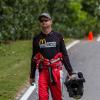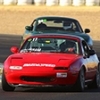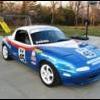Two good questions.
I rely on a sight picture for my own driving. I couldn't tell you that I turn at the third seam from the end of the fence post from memory. But I can very accurately turn at the same point every time based on the sight picture. And if I review video I can pick out reference points.
For coaching I do use reference points and sight picture by advancing video frame by frame. The typical word of caution is that you don't want to pick a reference point that can move from session to session. And certainly don't expect the lawn mowing crew to place brake markers back in the same place every time - always work your way up to the braking points...they may not be where you expect them to be based on the markers.
As you mention, the problem with reference points is that they can be obscured by a car in front, or during a pass. And...you're focusing on a point, not the entire view nor looking through the corner. So in terms of passing, if you're using reference points you'd need estimate where an obscured reference may be and mentally adjust.
If think the "innate sense" you mention falls more into the sight picture technique. One way I describe it is that the stars align, all the trees line up, and the combination lock hits the correct sequence. Everything falls into its visual place and that's your cue.
Reference points are a great way to learn and you can be fast using them, but if you've kept your eyes UP and have been looking through the corners and way ahead, the sight picture will start to develop. The more laps you get, the better the sight picture. The more times you are off line making a pass, the more data you have to develop alternative sight pictures which allow you to develop that "innate sense" and hold your position or make a pass off line.
For the second question - how close the drivers are says a lot about how much they trust the other drivers. There are guys you know you can count on to keep the car under them. You run them close. Then there are the wild card guys you don't even trust driving to grid. Lay off them going into the brake zones.
When following anyone, drive the track, NOT the bumper in front of you. You don't want to be following their lead or reacting to them, you want to be doing your thing so you don't make their mistakes.
Todd, how much do you rely on inanimate objects and other visual queues (other than actual brake markers) for your brake and turn-in points? Where you do use them but are in traffic, off line, or otherwise not at the ideal speed and position, do you still rely on the markers and adjust mentally, or more often fall back on your innate sense of when to brake or turn?
Somewhat related, when you are nose-to-tale behind someone and not trying to set up a pass, are you easing off just slightly approaching a corner then pretty much just reacting to / following their lead? We've all done this but sometimes watching video I'm impressed by how close one car stays behind the next even at the start of brake zones without inadvertently punting them.




 Sign In
Sign In Create Account
Create Account







 Back to top
Back to top Report
Report





















